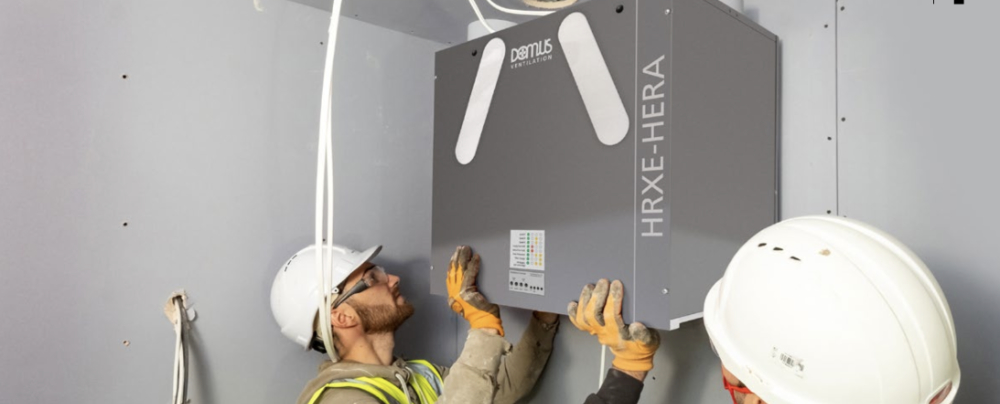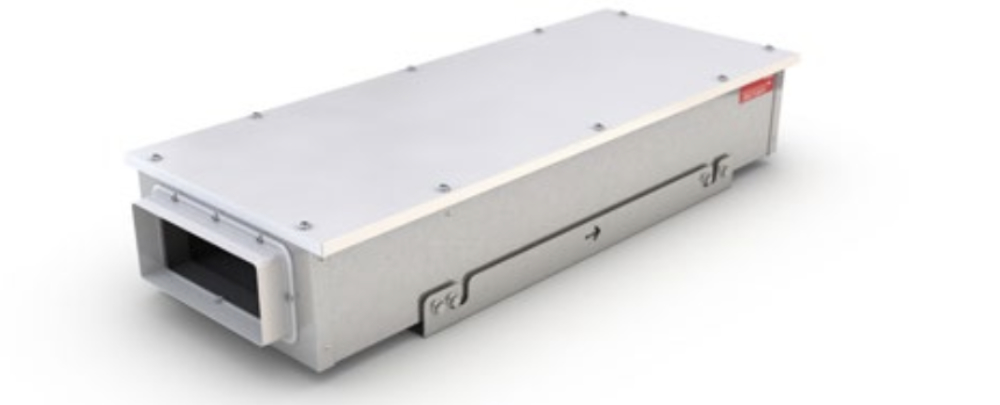Reasons for using MVHR systems
Contents |
[edit] MVHR in brief
Valued at $106.69 million in 2022, the Mechanical Ventilation Heat Recovery (MVHR) UK market is predicted to reach $235.34 million by 2030, with an annual growth rate of 10.73% from 2024 to 2030. This extraordinary growth is being driven by increased awareness of the benefits of MVHR, as well as the adoption of these systems to comply with the latest uplift to Building Regulations.
MVHR systems take a whole-house approach to ventilation, combining supply and extract ventilation into one system. They extract the stale air from wet rooms (kitchens, bathrooms, utility spaces) via ducting, transferring its heat to the fresh air being drawn into the building through heat exchanger. The filtered, pre-warmed air is then distributed around the home.
MVHR systems are a modern response to modern building practices. With ATs leading the charge to make properties more airtight and energy efficient, it is vital that good ventilation is designed into properties at the outset. If you are yet to be sold on these ventilation systems, allow me to present to you these key benefits:
[edit] Six reasons for using MVHR systems
[edit] Reason 1: Health
In the UK, we’re not an outdoors type of nation. In fact, we spend 80-90% of our time indoors. The air that we breath
indoors is therefore just as, if not more, important than the air we breathe outdoors, yet indoor air pollution can be up to five times higher than external.Sources of indoor air pollution are widespread and vary dramatically from house to house, but include cooking,cleaning products,furniture and outdoor emissions entering our homes. Then, of course, you have condensation and,in worst case scenarios,mould to contend with in the winter months.
Poor indoor air quality has been linked to an increased risk of respiratory and cardiovascular illness, cognitive impairment and certain cancers. England’s Chief Medical Officers Annual Report 2022 Air Pollution stated: “A better understanding of how we can prevent and reduce indoor air pollution should now be a priority”. It also noted “The role of ventilation is central to reducing unavoidable indoor air pollution.” MVHR systems are the most effective ventilation method for our homes as they both extract stale air and supply filtered ‘fresh’ air to key rooms, such as bedrooms. In urban areas that have high pollution levels, a NOX or PM2.5 pre-filter can be fitted in to the supply leg of an MVHR duct system to filter potentially dangerous pollutants from entering the home.Domus Ventilation’s NOX-FILT,for example, is highly effective as it prevents up to 99.5% of NO2 pollution from entering. Other steps that can be taken, as recommended in Building Regulations, include placing intake grilles away from the direct impact of the sources of local pollution.Areas in which urban traffic is the main source of that pollution,the air intakes should be as high as possible and located on the less polluted side of the building. Ventilation intakes should not be placed in courtyards or enclosed urban spaces where air pollutants are discharged.
[edit] Reason 2: Comfort
As we all know, breathing in poor quality air is not only unhealthy, it’s unpleasant. As stale air is usually the result of a buildup of chemicals (especially VOCs) and humidity, our homes feel stuffy and can have an unpleasant smell. Ironically, using an air freshener to combat this simply adds to the chemical concoction.MVHR systems are continuously on,removing that stale,humid air and its undesirable odours. During colder months they take the chill out of the supply air by passing it through a heat exchanger where the outgoing air’s energy is extracted and transferred. In the summer months,a 100% thermal bypass automatically activates when the air temperature reaches a pre-set level,allowing in cooler, fresh,filtered air without warming it through the heat exchanger.
[edit] Reason 3: Energy efficiency
By reusing the outgoing air’s heat to temper the incoming air, MVHR systems help reduce the home’s heating load too, with the Centre for Sustainable Energy estimating heating costs can be reduced by around 25%. Whilst MVHR running costs are dependent on the property size, building fabric, and occupant lifestyle,they are inexpensive to run.To ensure maximum energy efficiency is gained from an MVHR system though,it is important to correctly size,install and commission the unit, and use good quality ducting that is designed to work as part of that system.
[edit] Reason 4: Structural integrity
Whilst VOCs are unlikely to impact a building’s structure, persistent damp and mould can. If not dealt with, trapped condensation can lead to timber decay and can have a detrimental effect on insulation. More often though, it leads to mould growth on surfaces of walls and furniture. Removing large areas of mould is not easy and can be costly, especially when redecorating is required and furniture has to be replaced, with the mould likely to return as the source hasn’t been addressed. MVHR systems not only remove pollutants from homes,but also the humidity,reducing levels of condensation and preventing mould from forming in the first place.
[edit] Reason 5: Building Regulations
After changes to Building Regulations in June 2022, minimum ventilation rates have increased across all sizes of properties, reflecting the concern that previous ventilation levels were insufficient to reach all parts of a home (especially bedrooms overnight if doors are kept shut). In the case of larger properties,that increase is substantial.A five bedroom home, for example, has seen the minimum ventilation rate go from 29 to 43 litres per second. To achieve these new ventilation rates, mechanical ventilation systems such as MVHRs are the most proficient option. In larger properties, they are the only option!
[edit] Reason 6: Value-add
Thanks to campaign groups, scientists, and health professionals raising awareness,along with some high profile tragic cases where two children have died – one from air pollution and the other from mould in his home – the general public are more aware than ever of the importance of good air quality. Stories of extreme overheating in properties located in urban heat islands are also making national news. MVHR systems are an attractive proposition to home buyers who are worried about safety, providing them with good indoor air quality, added comfort and energy efficiency.
This article appears in the AT Journal issue 152 Winter 2024 as 'Six reasons you should be using MVHR systems' and was written by Paul Williams, Product Manager, Domus Ventilation.
--CIAT
[edit] Related articles on Designing Buildings
- Air conditioning.
- Air infiltration testing.
- Building services.
- Condensation.
- Cross ventilation.
- Displacement ventilation.
- Domestic ventilation systems performance.
- Exhaust air heat pump.
- Flanking sound.
- Heat recovery.
- Humidity.
- HVAC.
- Interstitial condensation.
- Mechanical ventilation.
- MVHR.
- Natural ventilation.
- Passivhaus.
- Passivhaus for affordable housing.
- Passivhaus Planning Package.
- Scotland mandates Passivhaus equivalent legislation.
- Stack effect.
- Thermal comfort.
- The UK's first passivhaus leisure centre.
- Understanding Passivhaus - review.
- Ventilation.
Featured articles and news
RTPI leader to become new CIOB Chief Executive Officer
Dr Victoria Hills MRTPI, FICE to take over after Caroline Gumble’s departure.
Social and affordable housing, a long term plan for delivery
The “Delivering a Decade of Renewal for Social and Affordable Housing” strategy sets out future path.
A change to adoptive architecture
Effects of global weather warming on architectural detailing, material choice and human interaction.
The proposed publicly owned and backed subsidiary of Homes England, to facilitate new homes.
How big is the problem and what can we do to mitigate the effects?
Overheating guidance and tools for building designers
A number of cool guides to help with the heat.
The UK's Modern Industrial Strategy: A 10 year plan
Previous consultation criticism, current key elements and general support with some persisting reservations.
Building Safety Regulator reforms
New roles, new staff and a new fast track service pave the way for a single construction regulator.
Architectural Technologist CPDs and Communications
CIAT CPD… and how you can do it!
Cooling centres and cool spaces
Managing extreme heat in cities by directing the public to places for heat stress relief and water sources.
Winter gardens: A brief history and warm variations
Extending the season with glass in different forms and terms.
Restoring Great Yarmouth's Winter Gardens
Transforming one of the least sustainable constructions imaginable.
Construction Skills Mission Board launch sector drive
Newly formed government and industry collaboration set strategy for recruiting an additional 100,000 construction workers a year.
New Architects Code comes into effect in September 2025
ARB Architects Code of Conduct and Practice available with ongoing consultation regarding guidance.
Welsh Skills Body (Medr) launches ambitious plan
The new skills body brings together funding and regulation of tertiary education and research for the devolved nation.
Paul Gandy FCIOB announced as next CIOB President
Former Tilbury Douglas CEO takes helm.
UK Infrastructure: A 10 Year Strategy. In brief with reactions
With the National Infrastructure and Service Transformation Authority (NISTA).


























